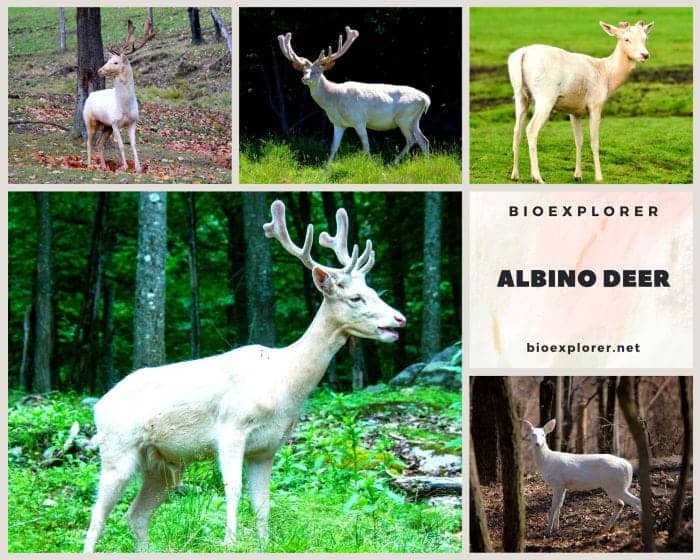
In August 2022, a rare albino deer was spotted and photographed in Michigan’s Upper Peninsula, making headlines. This ghostly white deer, with fur devoid of all pigmentation and eyes glowing pink, amazed those lucky enough to catch a glimpse.
Sightings like this spark fascination because albino deer stand out dramatically from the norm. Most deer are some shades of brown, while these white creatures look like they’ve been dipped in snow. But they’re not just white versions of typical deer.
Albino deer have a genetic condition that prevents their body from producing melanin. This pigment gives skin, fur, feathers, and eyes their color. This results in the complete lack of coloration we see in albino animals.
This article will cover everything you need to know about these unique deer. We’ll explore what albino deer are, why they have no color, where populations exist, just how rare they are, their challenges, controversies surrounding them, albino deer in captivity, why we find them so captivating, and more.
Let’s delve into the science and mysteries behind these white-tailed wonders!
Table of Contents
- What Are Albino Deer?
- Where Are Albino Deer Found?
- How Rare Are Albino Deer?
- Challenges Facing Albino Deer
- Albino Deer Controversies
- Albino Deer in Captivity
- The Fascination with Albino Deer
- Albino Deer Fun Facts
- Frequently Asked Questions
- What is the difference between white and albino deer?
- How rare is it to see a white or albino deer in the wild?
- What are the challenges faced by albino whitetail and other rare white deer?
- Is it bad luck to kill a white deer?
- Is there any difference between the antler of an albino deer and a regular deer?
- Can you share any recent sightings of albino deer?
- Are there any laws protecting rare white and albino deer?
- What’s a Piebald Deer?
- What are some famous white deer?
- How can I increase my chances of seeing an albino deer?
- Conclusion
What Are Albino Deer?
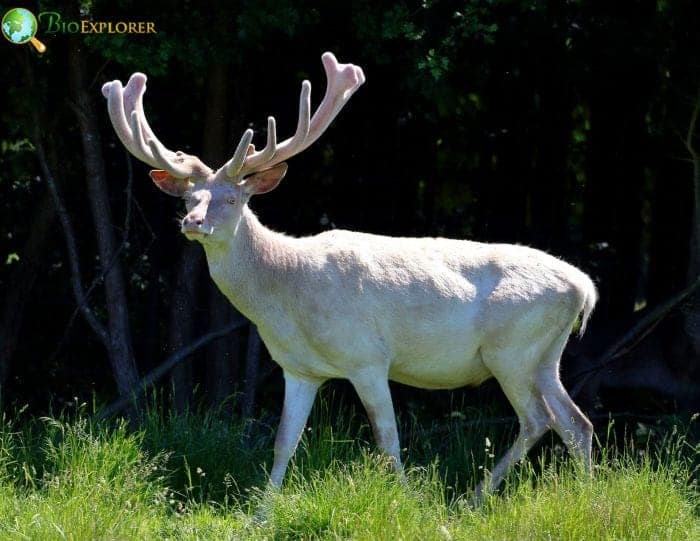
Albino deer are deer that have a genetic condition known as albinism. Albinism prevents the body from producing melanin, which is the pigment that gives skin, hair, fur, feathers, and eyes their coloration. Since albino deer lack melanin, their hair/fur and eyes are white.
The genetic mutation behind albinism in deer causes the animal to be unable to produce tyrosinase, an enzyme vital to melanin production. Since melanin helps provide protection from the sun’s UV rays, deer and other animals with albinism are very sensitive to sunlight.
It’s important to note the difference between albino deer and piebald deer. Piebald deer have irregular patches of white fur rather than being completely white. They do not have albinism but instead have a different genetic condition. Albino deer of all species, including whitetail deer, mule deer, elk, and moose, will be white with pink eyes.
Albinism is not just found in deer populations. Albino individuals occur in other animal species as well, though infrequently. Some other animals with documented albino variants include monkeys, ferrets, rabbits, squirrels, skunks, raccoons, and birds such as Albino Crows. However, lacking pigmentation makes albino deer stand out in the wild.
Where Are Albino Deer Found?

While albino deer can occur anywhere deer live, they are most commonly spotted in North America. This is likely due to the large whitetail and mule deer populations on the continent. Albino individuals have been documented in both of these species.
- Whitetail deer have the widest distribution of any North American deer, spanning southern Canada and South America. So, albino whitetails could theoretically appear throughout this range, though sightings are rare. Most reported cases seem to be concentrated in the Midwestern, Northeastern, and Southeastern United States.
- Mule deer have a more limited range in western North America. Albino mule deer are less common but have been observed in states like Montana, Colorado, California, and Utah. There are even rarer reports of albino elk and moose in these areas.
- Since the genetics behind albinism are not species-specific, it can appear in any deer population. However, the highest concentrations of albino deer occur where large herds exist, primarily in the Eastern and Midwestern US.
Even though sightings are unusual, you have a better chance of spotting one!
How Rare Are Albino Deer?
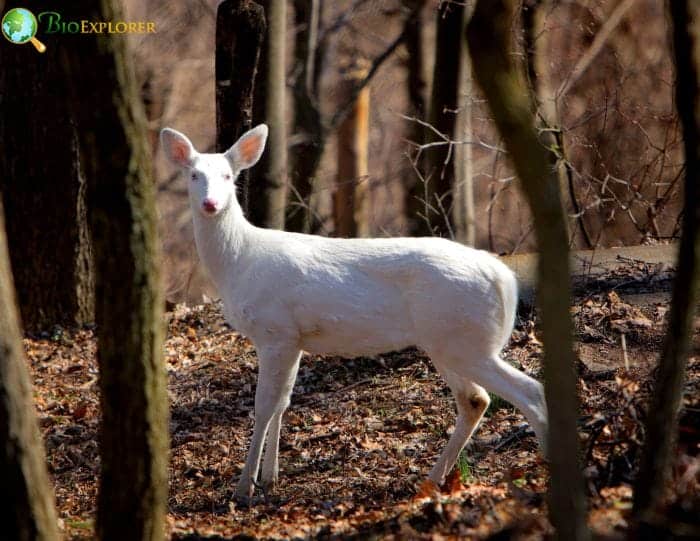
Albino deer are extremely rare animals. It is estimated that only about 1 in every 30,000 deer[1] born will be albino. In perspective, if a typical healthy deer population is around 15 deer per square mile, you would need a range of over 300 square miles to expect to see one albino fawn born[2].
Compare this to piebald or partially white deer, which are much more common. Approximately 1-2% of deer exhibit some amount of irregular white spotting or patches. A partially white piebald deer is not considered albino unless it completely lacks pigmentation. True albino deer stand out due to their all-white fur and distinctive pink eyes.
Several factors influence albino deer numbers and distribution:
- Genetic Outliers: Albinism is caused by a recessive gene, so both parents must carry the gene to potentially produce an albino offspring. Even if present, the recessive albinism gene may not always be expressed. An albino deer is more likely to be a random genetic outlier than indicative of a broader pattern.
- Isolated Populations: In small, localized deer populations where inbreeding is more likely, a recessive trait can become exaggerated over generations as gene diversity decreases. Some isolated areas may see slightly higher rates of albinism compared to the average.
- Herd Immunity: In most large, genetically diverse deer herds, albino deer do not thrive well enough to reinforce the trait. Albino coloring is disadvantageous for survival, so it remains a rare anomaly in healthy populations rather than becoming commonplace.
While unusual albino individuals can appear nearly anywhere deer live, the odds are low. Certain conditions like inbreeding can increase chances slightly in isolated groups. But across broad deer populations, a confluence of genetic factors is required to produce albino deer.
Even experts cannot predict occurrences or guarantee sightings. Spotting one in the wild remains special due to their extreme rarity.
Challenges Facing Albino Deer
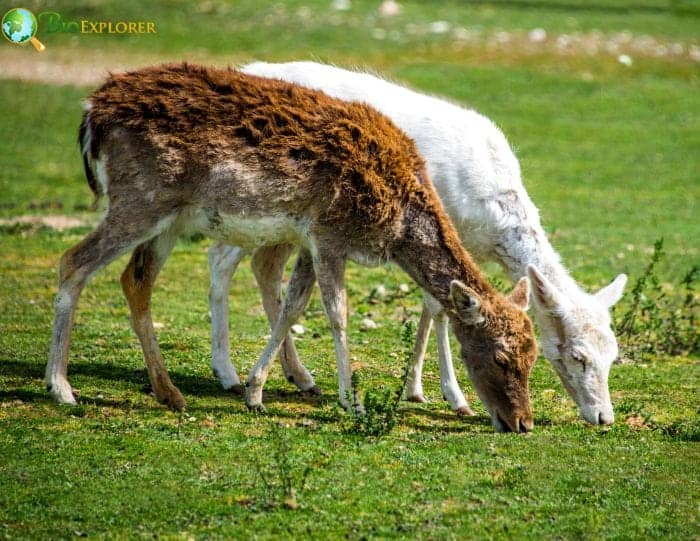
Although fascinating to observe, albino deer face some significant challenges due to their lack of normal pigmentation:
- Lack of Camouflage: The white fur of albino deer stands out starkly against most backdrops. This makes them far more visible to predators than deer with natural brown coloring. Without the ability to blend into their surroundings, albino deer can be targeted more easily.
- Sun Sensitivity: Melanin offers protection against the sun’s ultraviolet radiation. Without this pigment shield, albino deer are highly sensitive to the effects of UV exposure. Bright sunlight can damage their skin and eyes. Albino deer may stick to the shadows to avoid sun damage.
- Vision Issues: Albino deer often suffer from vision problems due to their pink eyes. The lack of pigment results in impaired optic nerve development and reduced visual acuity. Combined with sunlight sensitivity, partial blindness further hinders their survival.
- Hearing Difficulties: There is some evidence that albino deer have increased hearing loss compared to normal-colored deer. Auditory problems coupled with vision issues significantly impact their awareness of threats.
While not all albino deer exhibit poor eyesight or hearing, many only have partial sensory abilities. Between this and their visibility, albino deer are at a clear disadvantage in the wild compared to healthy, normally pigmented deer. Their survival depends heavily on staying vigilant.
Albino Deer Controversies
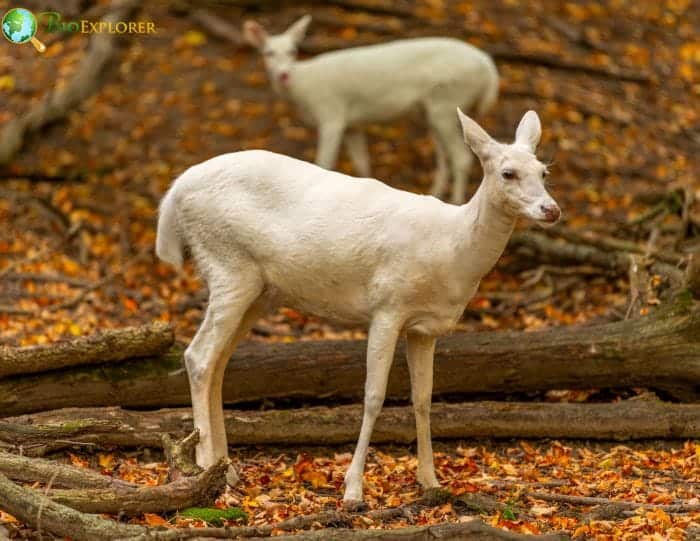
The rare and striking appearance of albino deer has resulted in some controversies surrounding how they should be treated:
- Unethical Hunting: Many worry that the rarity and unusual appearance of albino deer make them targets for unscrupulous hunters seeking a prize kill. Some have called for protective bans on hunting or shooting albino deer.
- Harassment by People: High public interest in albino deer has resulted in issues with people interfering with them in the wild. Getting too close to take photos, feeding them inappropriate food, or exposing them to pets increases risks. Wildlife officials caution people to admire albino deer from a distance.
- Predator Culling: Some argue predators like wolves or coyotes should be culled in areas with albino deer to protect them from predators they cannot camouflage from. Wildlife advocates counter that predator populations should not be managed solely for rare genetic anomalies.
- Removing Fawns: There have been cases of people removing albino fawns from the wild either for their novelty or to “save” them. Officials warn that this can harm herd health and caution people to avoid disturbing them.
While their unusual appearance incites fascination, it’s important albino deer be treated just like any other wild animal. Ethics and science should govern decisions on hunting bans, predator management, and human interactions involving albino deer. Their rarity does not necessarily warrant special treatment.
Albino Deer in Captivity
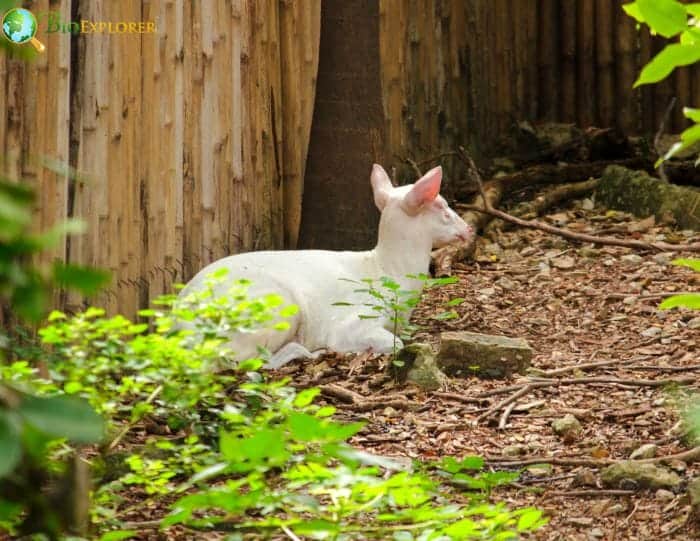
Although extremely rare in the wild, albino deer are sometimes found in controlled settings like zoos and wildlife parks:
- Some facilities intentionally breed animals with albinism to create exhibit populations of albino species. However, this is controversial due to potential inbreeding and albinism health impacts.
- Breeding programs seeking to produce albino deer have largely been unsuccessful. Due to the rarity of the recessive gene, even intentional pairings of deer carriers result in very low albino fawn rates.
- Most captive albino deer are rescued. If an albino fawn is found abandoned, some zoos or parks may take it in. Hand-raising increases the chances of survival.
- Albino deer generally don’t thrive well in captivity. The vision and hearing issues common in albinism make them prone to injury. Low pigmentation also causes skin problems.
- Zoos showcase albino deer mainly for visitor interest and education. But health, breeding, and cost challenges mean they are not commonly exhibited long-term.
While interesting to see, the high care demands and breeding difficulties make the maintenance of captive albino deer populations questionable. Zoos might display a rescued specimen, but most albino deer live out their life in the wild.
The Fascination with Albino Deer

What drives the intense interest and allure of albino deer? A few factors help explain their spellbinding effect:
- Striking Appearance: The complete lack of pigmentation makes a deer appear almost supernatural. The bright white coat and pink eyes look otherworldly against typical forest backdrops, commanding attention.
- Rarity: Unusually scarce Animals fascinate people. Albino deer are so rare that a sighting feels like spotting a unicorn in the woods. This rarity value stimulates curiosity and awe.
- Symbolic Meaning: In some cultures, white animals are thought to have mystical powers or be sacred omens. While not scientifically supported, the spiritual symbolism of albino deer resonates with some.
- Tourism Potential: Communities sometimes promote rare albino deer sightings to draw visitors. An unusual albino specimen can put a location “on the map” among those hoping to catch a glimpse.
While their limited senses hamper survival, albino deer have adapted well enough to continue appearing in very limited numbers. And as long as these ghostly white creatures maintain an aura of exceptional rarity, they will continue enthralling anyone fortunate enough to cross their path in the wild.
Albino Deer Fun Facts
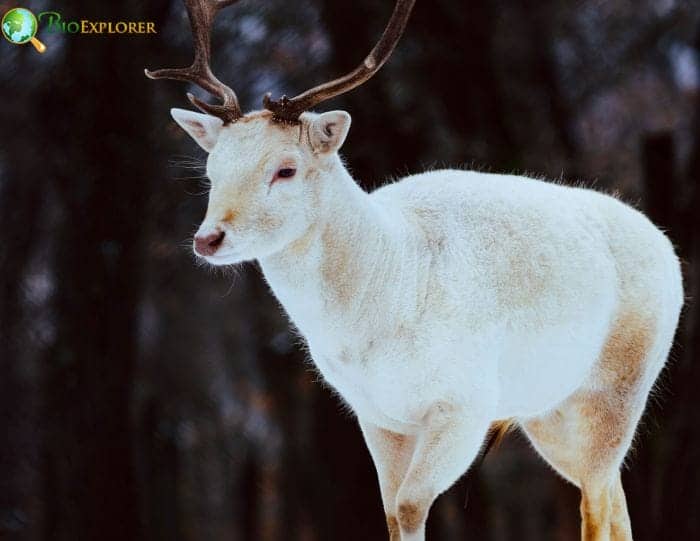
- Albino deer have a total absence of melanin, so their fur/hair and eyes are white.
- They are different from piebald deer, which have irregular white spotting. Albinos are entirely white.
- Only an estimated 1 in every 30,000 deer born will be albino, making them extremely rare.
- Albinism is found occasionally in other animals, like rabbits, bats, squirrels, birds, and even sharks.
- Lacking protective melanin, albino deer are sensitive to the sun and have vision problems.
- Native American tribes considered albino animals sacred spirits or omens.
- A few US states have banned hunting albino deer to protect this rarity.
- Zoos have rarely succeeded in intentional breeding programs for albino deer due to genetics.
- Reports of albino deer sightings can draw attention and tourists to an area.
- While unusual, albino deer are real animals occurring naturally like any other deer.
Frequently Asked Questions
What is the difference between white and albino deer?
A white deer could result from albinism and a less severe genetic trait called leucism. Albinism is a recessive trait where the animal lacks melanin, producing a white or mostly white coat color, white hair, and often pink or blue eyes. Leucistic deer also have a white or mostly white coat. Still, they don’t possess the gene for albinism and thus often retain some color in their eyes, hoofs, and antlers.
How rare is it to see a white or albino deer in the wild?
White and albino deer are rare to find in the wild. Statistically, the chance of producing an albino white-tailed deer can be as low as 1 in 30,000. Chances of seeing an albino deer are also significantly lower compared to sighting a brown deer due to the relative rarity of white genes and the increased survival challenges a deer of pure white color faces in the wild.
What are the challenges faced by albino whitetail and other rare white deer?
Albino whitetail and other rare white deer face several challenges for survival. Their white color makes them more visible to predators and less capable of camouflaging in the wild. Additionally, the gene for albinism may come with health problems such as poor eyesight.
Is it bad luck to kill a white deer?
This is largely a matter of folklore and personal belief. Some cultures view the white deer as a mystical creature and consider it bad luck to kill one. However, many hunters view the sighting of a rare white deer as an extraordinary event. They may choose to save the white deer instead of hunting it.
Is there any difference between the antler of an albino deer and a regular deer?
No, generally, there isn’t a noticeable difference between the antlers of an albino and a non-albino deer. The genetic trait that leads to albinism doesn’t typically affect the size or shape of a deer’s antler. Besides, both albino and “the albino deer” and normal deer shed and grow new antlers annually.
Yes, there are occasionally media reports of such rare sightings. For instance, a Tennessee couple recently spotted and photographed what appeared to be an albino deer in their backyard. They observed the deer for several months and watched its antlers grow from spots on its head to a full rack.
Are there any laws protecting rare white and albino deer?
Yes, certain jurisdictions have enacted laws to protect white and albino deer due to their rarity. These laws generally prohibit the hunting of these rare deer. However, the laws vary widely by region and country, so it’s always advisable to check local hunting regulations.
What’s a Piebald Deer?
A Piebald deer is a white-tailed deer with a genetic anomaly that causes it to have large white patches mixed with normal brown fur. Unlike albino deer, which are pure white, piebalds may be mostly white or only partly white. They can have a white or mostly white coat color because of their white genes. Still, they don’t suffer from health issues that typically accompany albinism.
What are some famous white deer?
One of the more famous groups of white deer is the herd living on the former Seneca Army Depot in New York[3], protected since World War II. Additionally, some singular “white deer” and “the albino deer” have become local celebrities in areas from Wisconsin to Texas when locals spot and recognize them.
How can I increase my chances of seeing an albino deer?
As albinos are rare, seeing one can be a challenge. Yet, you may increase your chances by spending more time in areas known for having albino deer, like the aforementioned Seneca Army Depot or certain parts of the Midwest where they’re more frequently reported. Always remember, though, that these creatures are protected in many areas and should be watched at a respectful distance.
Conclusion
Albino deer stands out as one of nature’s most fascinating genetic rarities. Their snowy white fur and luminous pink eyes look supernatural against typical woodland scenes. However, these deer differ from the norm due to a total lack of melanin pigment caused by a recessive albinism gene.
While captivating, albino deer face struggles in the wild due to their visibility and impaired eyesight and hearing. They are exceptionally scarce, with only 1 in every 30,000 deer born exhibiting albinism. Small isolated populations show slightly higher incidence, but albino deer remain extremely unusual across broad deer ranges.
These rare creatures have inspired a mix of controversies, from hunting bans to questionable captive breeding programs. But at the heart of each issue lies our shared fascination with albino deer. They invoke a sense of wonder precisely because they are so unlike 99.99% of their species. Their ghostly beauty in nature will likely continue enthralling people well into the future.











